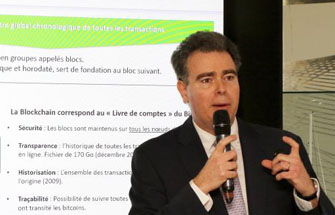Marketing Project Manager at Crédit Agricole SA, Grégory Chenue coordinates the Group’s work on Blockchain and Bitcoin projects. Monaco Press Club interviewed this specialist in all payment methods and ‘mobile’ assets on his favourite topics.
Can you explain simply what Bitcoins and Blockchains are?
Bitcoin was born in 2009, created by an anonymous person (Satoshi Nakamoto) within an IT security specialists’ community. The system has developed, with the idea of creating a means of exchange, ‘electronic cash’, allowing payments outside the banking system. So bitcoin is a form of currency used on a network – the bitcoin network.
As for blockchains, they all work on this type of distributed network. Internet works with servers hosting sites you connect to, that may break down. In blockchains, all network nodes are identical copies of one another. The most developed blockchain (bitcoin) has over 7000 nodes disseminated worldwide. It is impossible to destroy them all. This is the blockchain network’s strength.
What are the benefits for transactions, for example?
From the technical point of view, payments pass through the network directly without a centraliser managing accounts.
Blockchain transactions are recorded by packets called blocks, one after another. Each block of this chain contains a ‘summary’ of the previous block. Transactions are stored, one after another, in different blocks, but every time each block is a small part of the previous block’s information.
Blockchain’s global strength is its being disseminated and replicated worldwide, so being impossible to break, but from the microeconomic point of view each transaction is listed in a block and cannot be deleted.
This provides a history of all transactions. It is valid for bitcoin and also for all blockchains.
Hackers have to focus on blockchains…
The technology is inviolable for two reasons: the network is disseminated, and from the technical point of view no-one has managed to hack the system because as time goes on transactions are logged and impossible to modify.
With this technology, international transfers can be very quick. A transaction registered in a blockchain is immutable: this can be a plus for traders, even if it does not call into question their commercial obligations. Coin transactions can have 8 digits after the decimal point: we could pay ‘euro dust’ i.e. coin dust for transactions involving extremely low amounts. This allows real micro-transactions.
For example, to pay for part of a hired film you have seen without watching it to the end, or buy an article without taking out a subscription.
Beyond transactional aspects you can use a blockchain in the banking field to store and archive exchanges of shares, signatories to a contract or any type of document.
And what about the much talked about cryptocurency?
Four years ago, my bank’s management asked me to look at this subject. Crédit Agricole is part of a consortium of French banks and insurance companies who pool bitcoin/blockchain specialists who conduct tests per profession: trading, insurance, fund management. Everyone is testing the capabilities of blockchains. At present, French banks prefer not to invest in cryptocurrency short and long. Apart from their real speculative risks, they lack a legal and regulatory framework. Some recent announcements suggest that one should be in place within the year.






